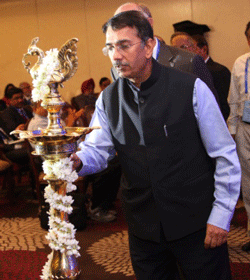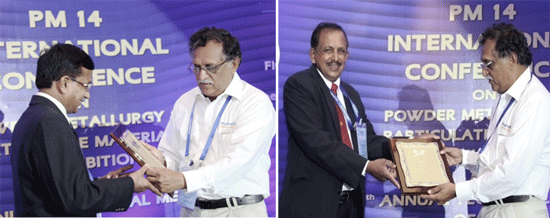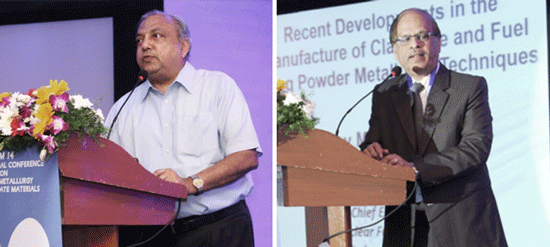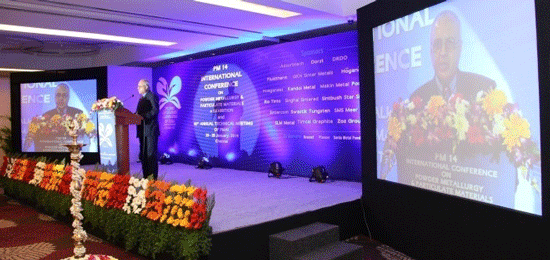PM-14 India report: International conference and exhibition held in Chennai
This year’s PM-14 conference was held in the city of Chennai, an automotive hub since the 1960s with large manufacturers of auto parts as well as hundreds of SMEs in the areas of Ambattur and Guindy. The city is the largest commercial region in South India and a major cultural and educational centre.
PM-14 began with a welcome to participants by N Gopinath, President of the PMAI. The welcome was followed by the traditional ‘Lighting of the Lamp’ ceremony, symbolising the spreading and sharing enlightenment. This year the lamp was lit by Shekar Viswanathan, Prof Ramakrishnan, Dr Rama Mohan, Greg Lavallee, Dr S Ashok, Dr Deep Prakash and N Gopinath.
The opening ceremony included a presentation from Professor P Ramakrishnan, Professor Emeritus at IIT (Bombay) and a pioneer in Powder Metallurgy.
The Indian Automobile Industry: Vision 2020

Chief Guest Shekar Viswanathan,
Vice-Chairman and Whole Time Director
of Toyota Kirloskar Motor Company,
inaugurating the conference by lighting
the traditional lamp
In the inaugural address by Shekar Viswanathan, Vice-Chairman and Whole-time Director of Toyota Kirloskar Motor Company, Vision 2020 and the future of the automobile industry in India was discussed.
Viswanathan stated that as the rapid consumption of primary resources continued, recycling is likely to emerge as a major consideration, probably aided by legislation. He added that mixed fuels will gain importance in the auto sector, though this will be gradual so as to reduce oil industry issues as well as the problems associated with conversion from Euro IV to Euro V.
Hybrid or electric vehicles with incentives to users will slowly come into the market, stated Viswanathan. Fuel cell vehicles with hydrogen may be used over the long term, he stated. Viswanathan believes that the newer technologies will be introduced gradually as opposed to witnessing sudden changes.
Currently the automobile industry in India is highly taxed, second only to the tobacco industry, stated Viswanathan. In the future it is hoped that growth will be encouraged by refinements in taxation and public finance. Tax should certainly not be based on the size or capacity of vehicles as it is now, added Viswanathan. He estimated that the current 3.2 million cars will grow to five million by 2020.
PMAI Fellowship Award
Each year the PMAI recognises those who have contributed to the science and practice of Powder Metallurgy as well as those who have served the PMAI by awarding them the title Fellow of PMAI.

Narasinh Chandrachud (left), formerly of GKN Sinter Metals Ltd, India, and P N S Sivan (right), CEO of Sintbush (India) Pvt. Ltd, were elevated to Fellow of PMAI at PM-14
This year the PMAI presented two awards, the first to Narasinh Chandrachud, formerly of GKN Sinter Metals Ltd, India, and the second to P N S Sivan, CEO of Sintbush (India) Pvt. ltd. The presentation was made by Dr S Ashok, Director, Höganäs India who had earlier worked with Sundram Fasteners and was responsible for the creation of Sundram Bleistahl Ltd.
The PM-14 exhibition
This year’s exhibition was by far the largest the PMAI has organised. The official opening took place during the inaugural session and was opened by Greg Lavallee, Quebec Metal Powders Rio Tinto.

Greg Lavallee, Quebec Metal Powders Rio Tinto, Canada, inaugurated the exhibition through a traditional ribbon cutting ceremony. Left to right Dr. Deep Prakash, Greg Lavallee, N Gopinath, Dr P Ramakrishnan and Dr T R Rama Mohan
Plenary session focuses on new applications for particulate materials
The first plenary session of the conference was devoted to the topic of new applications for particulate materials. Dr G Sundararajan, Director of the International Advanced Research Center for PM and New Materials, India (AR CI), began the session with the S L N Acharyulu memorial lecture on ‘Powders to products: ARCI’s experience’.
During his presentation Sundararajan covered R&D efforts in various materials. Sundararajan stated that powders for Oxide dispersion strengthened steels for a reactor have been developed by mechanical alloying of stainless steel powders along with yttria. Nano ZnO powders made by spray pyrolysis and combustion synthesis were discussed. The sintered varistors of 1 to 5 µm grain size demonstrated high break down voltage of 2 KV/ cm.
Sundararajan stated that Mg-Al2O3 transparent spinel for dental brackets, lenses etc., have been developed by slurry casting, extrusion, sintering and Hot Isostatic Pressing. He also discussed the developments in Al2O3- ZrO2-TiCN nano composite cutting tools, Ni-Cr-Al-Y coatings and laser clad coatings for burner tip plates.

Dr G Sundararajan, Director, ARCI, (left) and Dr N Saibaba, CEO, NFC (right) speaking during the PM-14 plenary session
The plenary session continued with the P R Roy Memorial lecture presented by Dr N Saibaba, CEO of Nuclear Fuel Complex India (NFC), on ‘Recent Developments in the Manufacture of Clad Tube and Fuel using Powder Metallurgy Techniques’.
Ceramic fuels, UOX or MOX in form of cylindrical pellets are most extensively used in power reactors, stated Saibaba. Worldwide, powder metallurgical techniques are employed for the fabrication of these nuclear fuel pellets to meet design objectives such as heat-transfer, structural and mechanical integrity etc.
The concentrated, purified and ammonium diuranate precipitated stabilised uranium dioxide powder is compacted and sintered at high temperature to form uranium dioxide pellets. Some of the successful R&D projects carried out at NFC include; Zircalloy loaded sintered UOx fuel pellets; removal of Hf from ZrO2; ODS ferritic martensitic steel clad tubes and plates; sintering of UOx at about 1700°C in hydrogen to 96-98% theoretical density; granules made from rotary pressed sheets as well as from roll compaction; improvements of die life by 30% using WC sleeved dies; use of 100% organic lubricants, and the introduction of an automatic pellet charging and sintering system.
The first plenary session concluded with the presentation “Driving your car with Nanostructures – H2Tank2Go® from aviation to on road transportation” by Dr Henning Zoz, Zoz Group, Germany. Dr Zoz stated that the Zoz group became a player in the green economy because of the long term possibilities for nanostructured materials in energy storage and conversion.
One of the key benefits of the project, stated Dr Zoz, are the quickly replaceable hydrogen-tanks carrying the nanostructured solid state absorber Hydrolium® which are capable of “on road” refueling. Together with the “Power to Gas to Fuel” scenario that Dr Zoz discussed there could be significant potential for the use of this technology.
The presentation continued on from Dr Zoz’s talk at last years event (PM-13) where he reported on ‘H2-OnAir’ project with EADS, Airbus, IFB et al., in which the Zoz Group developed small H2-solid-state absorber tanks for use in aircarft. The project is expected to triple the range of the Icaré Solar Airplane.
In the on-road demonstration phase discussed at PM-14, Zoz employed zero emission electrical vehicles. The current Zoz ZEV fleet consits of a Stromer ebike, and cars including four Fiat 500s, two Mattiz and three Fiorinos. The project will see the H2 energy platform from the H2-OnAir transferred to all fleet vehicles. Dr Zoz stated that the Zoz group is ready to offer the first ever local private passenger transportation system fully powered by hydrogen and meeting all safety, legal and economic conditions.
There were a total of 26 papers presented in the remaining five plenary sessions and a further 36 papers presented in parallel sessions on Metallics, Ceramics and Composites and the PM industry. A special session on ‘Additive Manufacturing and Functionally Gradient Materials’ also took place during PM-14.






